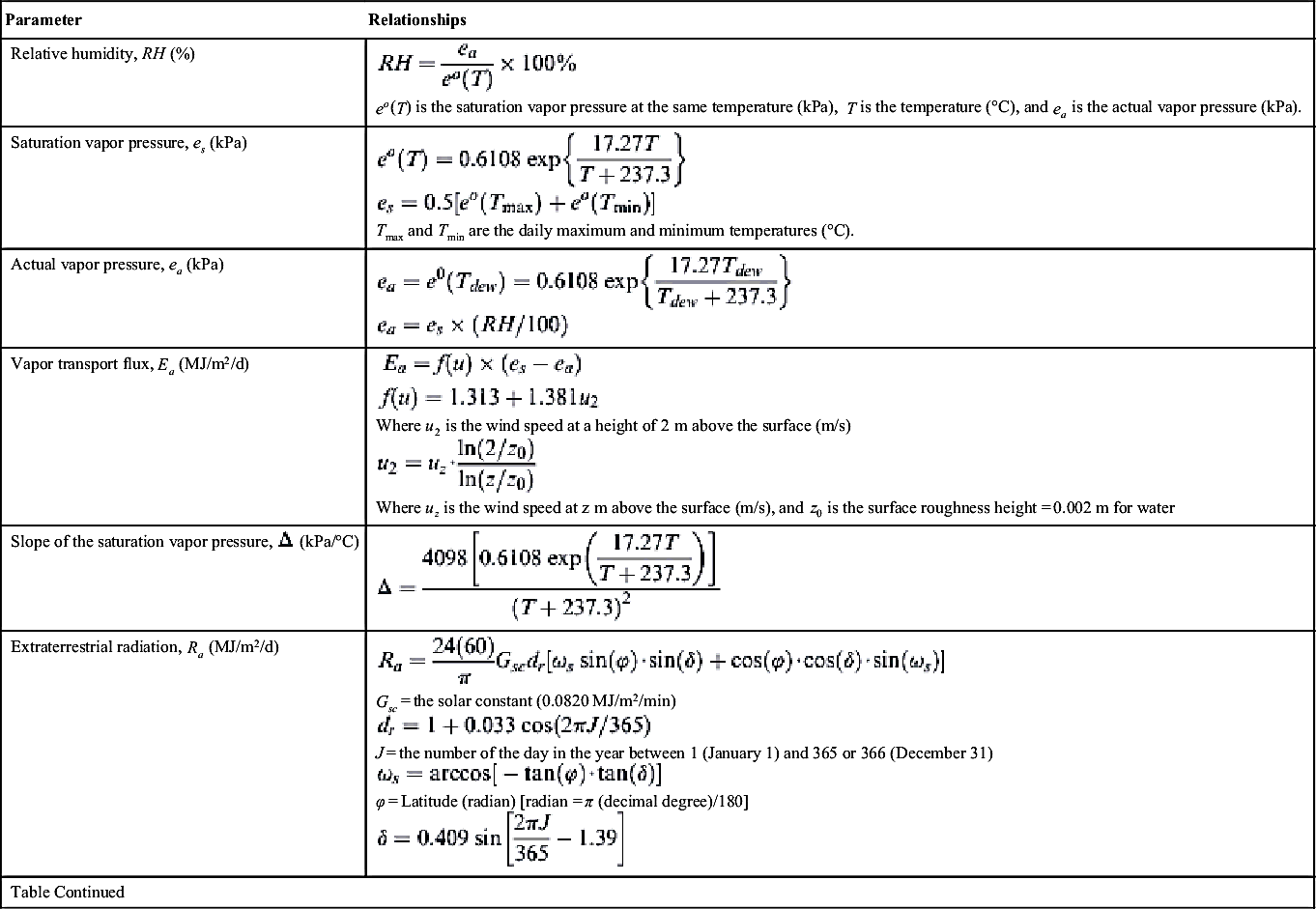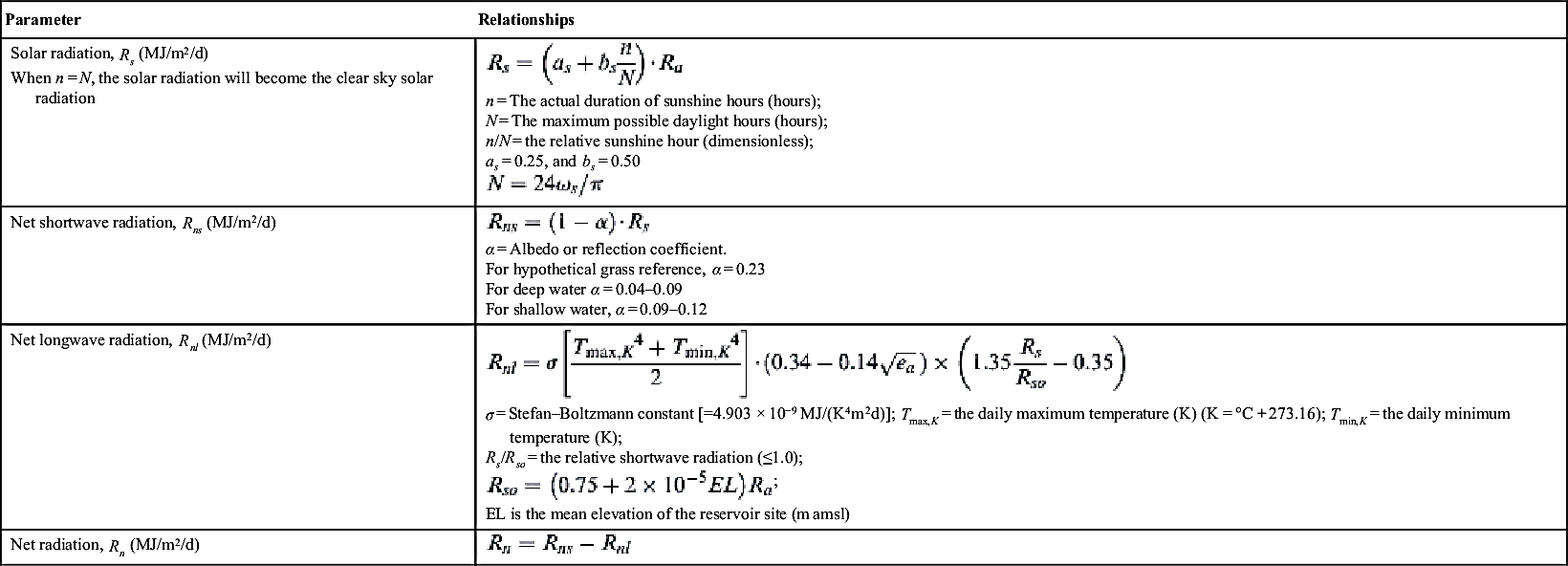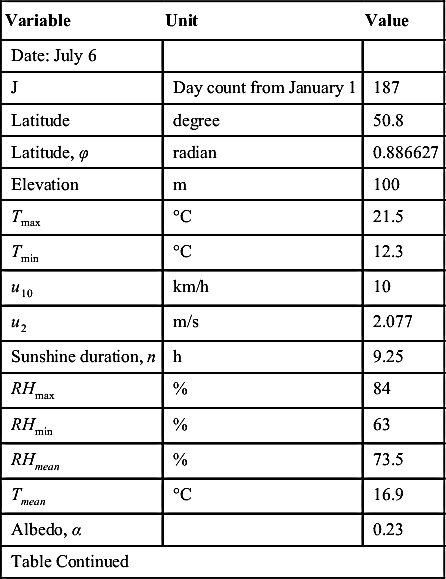Estimation of Lake Evaporation and Potential Evapotranspiration
Abstract
Evaporation is one of the major losses from lakes and reservoirs, which requires to be accounted for water budgeting. When there is no instrumentation available for the direct measurement of lake evaporation, it becomes necessary to use models for its estimation. The Penman method is considered as one of the most reliable methods for estimating lake evaporation and is discussed in sufficient detail in the chapter. Besides estimating the evaporation loss from reservoirs, estimation of reference crop evapotranspiration or potential evapotranspiration is also required, which forms the basis of estimating the crop water requirement for irrigation planning. In this chapter, the Penman–Monteith method and ASCE-EWRI Standardized Penman–Monteith equation are discussed in detail along with the Hargreaves method for limited meteorological data availability.
Keywords
5.1. Estimation of Lake Evaporation
Table 5.1
Auxiliary Equations Used for Penman Method
| Parameter | Relationships |
| Relative humidity, RH (%) | eo(T) is the saturation vapor pressure at the same temperature (kPa), T is the temperature (°C), and ea is the actual vapor pressure (kPa). |
| Saturation vapor pressure, es (kPa) | Tmax and Tmin are the daily maximum and minimum temperatures (°C). |
| Actual vapor pressure, ea (kPa) | |
| Vapor transport flux, Ea (MJ/m2/d) | Where u2 is the wind speed at a height of 2 m above the surface (m/s) Where uz is the wind speed at z m above the surface (m/s), and z0 is the surface roughness height = 0.002 m for water |
| Slope of the saturation vapor pressure, |  |
| Extraterrestrial radiation, Ra (MJ/m2/d) | Gsc = the solar constant (0.0820 MJ/m2/min) J = the number of the day in the year between 1 (January 1) and 365 or 366 (December 31) φ = Latitude (radian) [radian = π (decimal degree)/180] |
| Table Continued | |

| Parameter | Relationships |
Solar radiation, Rs (MJ/m2/d) When n = N, the solar radiation will become the clear sky solar radiation | n = The actual duration of sunshine hours (hours); N = The maximum possible daylight hours (hours); n/N = the relative sunshine hour (dimensionless); as = 0.25, and bs = 0.50 |
| Net shortwave radiation, Rns (MJ/m2/d) | α = Albedo or reflection coefficient. For hypothetical grass reference, α = 0.23 For deep water α = 0.04–0.09 For shallow water, α = 0.09–0.12 |
| Net longwave radiation, Rnl (MJ/m2/d) | σ = Stefan–Boltzmann constant [=4.903 × 10−9 MJ/(K4m2d)]; Tmax,K = the daily maximum temperature (K) (K = °C + 273.16); Tmin,K = the daily minimum temperature (K); Rs/Rso = the relative shortwave radiation (≤1.0); EL is the mean elevation of the reservoir site (m amsl) |
| Net radiation, Rn (MJ/m2/d) |

| Variable | Unit | Equation | Value |
| Latitude | degree | 28.57974 | |
| Elevation | m | 630 | |
| Tmax | °C | 15 | |
| Tmin | °C | 8 | |
| Tdew | °C | 10.44 | |
| u2 | m/s | 1.25 | |
| Sunshine duration, n | h | 8 | |
| Tmean | °C | =0.5(Tmax + Tmin) | 11.5 |
| Albedo, α | 0.23 | ||
| Psychometric constant, γ | kPa/°C | 0.059 | |
| Saturation vapor pressure, | kPa | Tmax and Tmin are the daily max and minimum temperatures (°C). | 1.389058 |
| Actual vapor pressure, | kPa | 1.264641 | |
| Vapor pressure deficit | kPa | = | 0.124416 |
| Wind function, f(u) | = | 7.555 | |
| The vapor transport flux, Ea | MJ/m2/d | Where u2 is the wind speed at a height of 2 m above the surface (m/s) Where uz is the wind speed at z m above the surface (m/s), and z0 is the surface roughness height = 0.002 m for water. | 0.940 |
| Table Continued | |||

| Variable | Unit | Equation | Value |
| J Corresponding to January 1 | 1 | ||
| The latitude, φ | radian | radian = π (decimal degree)/180 | 0.498811 |
| The inverse relative distance of the earth from the sun, dr | 1.032995 | ||
| The sunset hour angle ωs is | radian | 1.337724 | |
| The solar declination, δ | radian | −0.40101 | |
| The maximum possible sunshine duration, N | h | 10.21946 | |
| The relative sunshine duration, n/N | – | =n/N | 0.78282 |
| The extra-terrestrial radiation, Ra | MJ/m2/d | 20.84294 | |
| The solar radiation, Rs | MJ/m2/d | n = the actual duration of sunshine hours (h); N = the maximum possible daylight hours (h); n/N = the relative sunshine hour (dimensionless); as = 0.25, and bs = 0.50 | 13.36888 |
| The clear-sky solar radiation, Rso | MJ/m2/d | 15.89483 | |
| The net shortwave radiation, Rns | MJ/m2/d | For hypothetical grass reference, For deep water For shallow water, | 10.29403 |
| Tmax | K | K = °C + 273.16 | 288.16 |
| Tmin | K | K = °C + 273.16 | 281.16 |
| The net longwave radiation, Rnl | MJ/m2/d | 4.62057 | |
| The net radiation, Rn | MJ/m2/d | 5.67347 | |
| The soil heat flux, G | MJ/m2/d | 0.0 | |
| The reference crop evapotranspiration, | MJ/m2/d | =E/2.45 | 3.7970 |
| The reference crop evapotranspiration, | mm/d | 1.5492 |

5.2. Estimation of Reference Crop Evapotranspiration
5.2.1. FAO-56 and ASCE-EWRI Method
 (5.4)
(5.4) (5.5)
(5.5)5.2.2. Hargreaves Method
Table 5.2
Auxiliary Equations Used for Penman–Montieth Method
| Parameter | Relationships |
| Relative humidity, RH (%) | eo(T) is the saturation vapor pressure at same temperature (kPa), T is the temperature (°C), and ea is the actual vapor pressure (kPa) |
| Saturation vapor pressure, es (kPa) | Tmax and Tmin are the daily maximum and minimum temperatures (°C) |
| Actual vapor pressure, ea (kPa) | |
| U2 (m/s) | Where uz is the wind speed at z m above the surface (m/s) and z0 is the surface roughness height = 0.002 m for water |
| Slope of the saturation vapor pressure, |  |
| Extraterrestrial radiation, Ra (MJ/m2/d) | Gsc = the solar constant (0.0820 MJ/m2/min) J = the number of the day in the year between 1 (January 1) and 365 or 366 (December 31) φ = Latitude (radian) [radian = π (decimal degree)/180] |
Solar radiation, Rs (MJ/m2/d) When n = N, the solar radiation will becomes the clear sky solar radiation. | n = The actual duration of sunshine hours (h); N = the maximum possible daylight hours (h); n/N = the relative sunshine hour (dimensionless); as = 0.25, and bs = 0.50. |
| Net shortwave radiation, Rns (MJ/m2/d) | α = Albedo or reflection coefficient. For hypothetical grass reference, α = 0.23 |
| Net longwave radiation, Rnl (MJ/m2/d) | σ = The Stefan–Boltzmann constant [=4.903 × 10−9 MJ/(K4m2d)] Tmax,K = The daily maximum temperature (K) (K = °C + 273.16); Tmin, K = the daily minimum temperature (K); and Rs/Rso = The relative shortwave radiation (≤1.0). Where Rso is the clear-sky solar radiation (MJ/m2/d), EL = the mean elevation of the reservoir site (m amsl). |
| Table Continued | |

| Parameter | Relationships |
| Net radiation, Rn (MJ/m2/d) | |
| Soil heat flux, G (MJ/m2/d) | For daily time periods, the magnitude of G averaged over 24 h beneath a fully vegetated grass or alfalfa reference surface is relatively small in comparison with Rn. Therefore for daily computation of ET0, G can be ignored (i.e., G = 0). For water surface, G = 0 |
| Psychometric constant, γ (kPa/°C) | Where, P is the atmospheric pressure (kPa), λ is the latent heat of vaporization (2.45 MJ/kg), cp is the specific heat at constant pressure (1.013 × 10−3 MJ/kg/°C), and ε is the ratio of molecular weight of water vapor to that of dry air = 0.622 The simplified equation for relating the atmospheric pressure and elevation above the mean sea level can be given as follows: |

| Variable | Unit | Value |
| Date: July 6 | ||
| J | Day count from January 1 | 187 |
| Latitude | degree | 50.8 |
| Latitude, φ | radian | 0.886627 |
| Elevation | m | 100 |
| Tmax | °C | 21.5 |
| Tmin | °C | 12.3 |
| u10 | km/h | 10 |
| u2 | m/s | 2.077 |
| Sunshine duration, n | h | 9.25 |
| RHmax | % | 84 |
| RHmin | % | 63 |
| RHmean | % | 73.5 |
| Tmean | °C | 16.9 |
| Albedo, α | 0.23 | |
| Table Continued | ||

| Variable | Unit | Value |
| Psychometric constant, γ | kPa/°C | 0.0655 |
| Δ | kPa/°C | 0.12211 |
| Saturation vapor pressure, | kPa | 1.9975 |
| Actual vapor pressure, | kPa | 1.46815 |
| Vapor pressure deficit | kPa | 0.52933 |
| The inverse relative distance of the earth from the sun, dr | 0.9670989 | |
| The sunset hour angle ωs is | radian | 2.108088 |
| The solar declination, δ | radian | 0.395436 |
| The maximum possible sunshine duration, N | h | 16.1046 |
| The relative sunshine duration, n/N | – | 0.57437 |
| The extraterrestrial radiation, Ra | MJ/m2/d | 41.088 |
| The solar radiation, Rs | MJ/m2/d | 22.072 |
| The clear-sky solar radiation, Rso | MJ/m2/d | 30.8984 |
| The net shortwave radiation, Rns | MJ/m2/d | 16.9955 |
| Tmax | K | 294.66 |
| Tmin | K | 285.46 |
| The net longwave radiation, Rnl | MJ/m2/d | 3.63810 |
| The net radiation, Rn | MJ/m2/d | 13.35738 |
| The soil heat flux, G | MJ/m2/d | 0.0 |
| Term1a | 0.6655 | |
| Term2a | 0.2239 | |
| Term3a | 0.2340 | |
| ETo (Penman–Monteith)b | mm/d | 3.8005 |

| Parameters of the Hargreaves Method | Unit | Value |
| Date | July 6 | |
| J (day count since January 1) | 187 | |
| Tmean | °C | 16.9 |
| Tmax | °C | 21.5 |
| Tmin | °C | 12.3 |
| Lat | degree | 50.8 |
| Lat | radian | 0.886627 |
| Elevation, z | m | 100 |
| Atmospheric pressure, P | kPa | 0.0655 |
| Psychometric constant,γ | kPa/°C | 0.0656 |
| The inverse relative distance of the Earth from the sun, dr | 0.9671 | |
| The sunset hour angle ωs | radian | 2.1080 |
| The solar declination, δ | radian | 0.3954 |
| Ra | MJ/m2/d | 41.0884 |
| ETo using the Hargreaves method | mm/d | 4.0582 |
